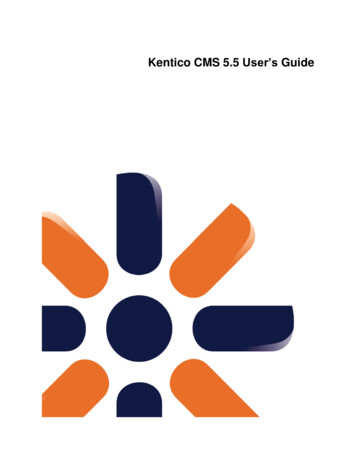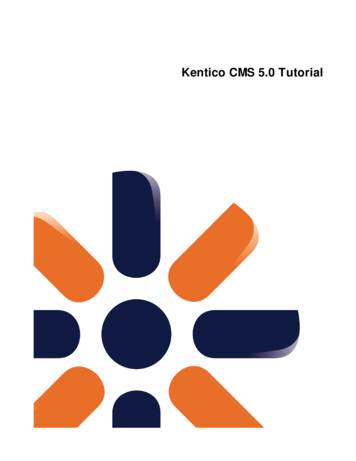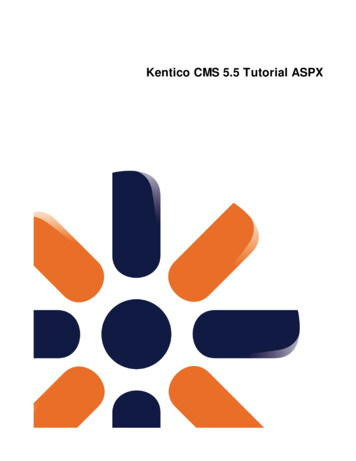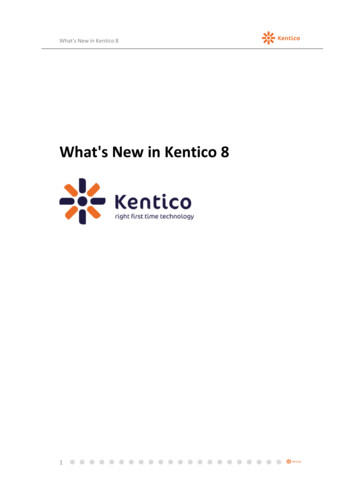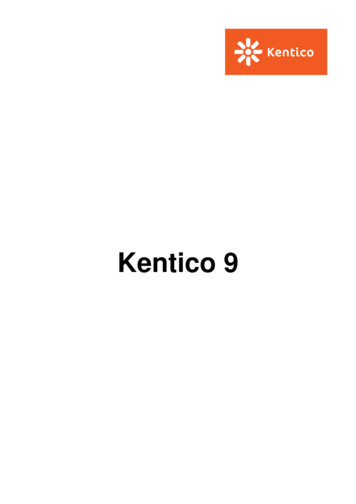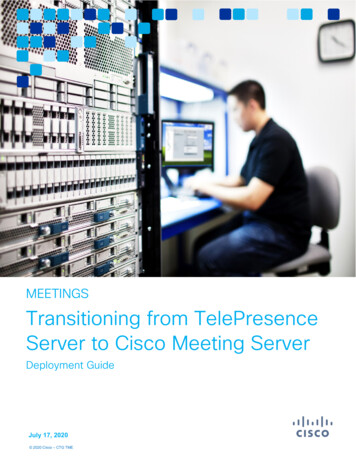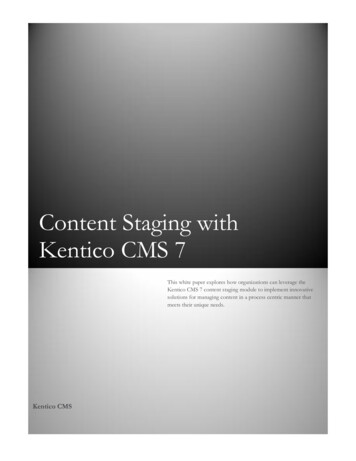
Transcription
Content Staging withKentico CMS 7This white paper explores how organizations can leverage theKentico CMS 7 content staging module to implement innovativesolutions for managing content in a process centric manner thatmeets their unique needs.Kentico CMS
For more information: www.kentico.comContent Staging with Kentico CMSTABLE OF CONTENTSExecutive Summary . 2Scope and Goals . 2Target Audience . 2What Is Content Staging . 2People and Processes . 3The Value of Content Staging . 3Integrating Content Staging into Governance Processes . 3Defining a New Content Governance Process . 4The Kentico CMS Approach . 5Kentico CMS Content Staging Module . 5Staging Categories . 6Security. 7Programmatic Access . 8Implementing Content Staging with Kentico CMS . 9What You Can Expect . 9Architecting Content Staging with Kentico CMS . 10Architectural Guidelines and Best Practices . 10Support Multiple Item Lifecycles . 10Deploy Staging Servers Behind the Firewall . 11Define Content Staging Roles . 12Understand Synchronization Volume and Performance Impact . 13Provide Each Role the Minimum Set of Permissions Necessary . 13Other Options for Content Synchronization . 13Site Import and Export . 13Workflow . 13Conclusion . 14About Kentico . 14Page 1
For more information: www.kentico.comContent Staging with Kentico CMSEXECUTIVE SUMMARYSCOPE AND GOALSIt is the goal of this document to detail the features, design and best practices for utilizing the Kentico CMS contentstaging module.This document focuses exclusively on content staging and does not provide an in-depth analysis of other Kentico CMSfeatures or the Kentico CMS platform, except where necessary to provide context. After completing this white paper,the reader should understand: The purpose of content stagingExample business scenarios for leveraging the technologyThe business case for implementing content stagingConfiguration of the Kentico CMS content staging moduleArchitecture, design and implementation best practicesTARGET AUDIENCEThis white paper targets hands-on implementers of Kentico’s content management system (CMS). The reader may be ina role such as: AdministratorSite managerDevelopersupporting the Kentico CMS platform. Readers should have general technical knowledge of the Kentico CMS platform.However, it is not necessary to have an in-depth understanding of content staging or the Kentico CMS content stagingmodule.While not specifically targeted at a non-technical audience, non-technical readers can use this white paper to understandthe value of implementing content staging and get details for creating a business case.WHAT IS CONTENT STAGINGContent staging is the practice of deploying changes to one or more servers outside of the development environment,such as content review, quality assurance, security validation or performance testing, before deploying to production.Despite the name, content staging is not just about staging visible content.One of the key advantages of using acontent management system is theseparation of content frompresentation and layout. Contributorscreate content in a display agnosticformat and the system combines thecontent with templates, customcomponents and data to create aWhy is it necessary to separate staged changes? Changes applied toa staging environment could easily affect production.Page 2
For more information: www.kentico.comContent Staging with Kentico CMSfinished web page. This strategy speeds delivery and allows resources to perform the tasks which they are most suited.Content staging ideally addresses all aspects of managing content in a CMS – not just the content.Content staging processes allow staff and/or test suites to verify changes and their impacts before applying them to aproduction site. Content staging processes may support content approval, review and manual or automatedsynchronization of changes among source and target servers.In general, servers housing staged changes should be separate from production. In virtualized or cloud-basedenvironments, “separate” does not necessarily imply physically separate hardware, but rather separation in terms ofoperational environments.Why is it necessary to separate staging? Changes applied to items other than content in a staging environment with a livesystem could easily impact production: changes to shared components, high resource utilization during a load test or anill-behaved custom component could have a dramatic negative impact on production or cause a complete outage.Additionally, if changes include more than content, organizations should consider staging the changes behind a firewallto minimize the risk of exposing security issues to the internet before validating their safety.PEOPLE AND PROCESSESTHE VALUE OF CONTENT STAGINGThere is no single model that works for all organizations for content staging. An organization that has one resourcemodifying and approving content with no developers has much different needs and control requirements than a largeorganization with departmental sites, custom code and site designers. Content management solutions like Kentico CMSprovide business users the power and autonomy to manage their own content. It allows those who understand thebusiness to manage their information assets, while simultaneously allowing technical and design resources to managefunctionality and appearance. This model has a number of benefits, but decentralized content management alsointroduces a number of complexities.Why stage content? Organizations have many reasons for wanting to stage changes prior to deploying to production: Does the content adhere to organizational compliance policies and standards?Is the content grammatically correct?Have accessibility requirements been taken into account?Has a custom component/code been tested?Does a new template or layout adhere to organizational or departmental design guidelines?Does the content duplicate existing content?No matter what the specific reason, the value of a CMS solution is only as good as its underlying content. Governanceprocesses and tools to systematically enforce them, like the Kentico CMS content staging module, enable organizationsto avoid wasting resource time troubleshooting issues, reworking content or worse legal issues and fines related tocompliance violations. Reviewing changes and ensuring they are correct prior to production deployment often takesmuch less time and effort – and definitely stress - than discovering a problem on a live site.The Kentico CMS content staging module should not be used in isolation by technical resources. Although contentstaging is a tool, it is important that it be supported by users with well-defined responsibilities and a clearly understoodprocess about how changes move between environments to production.INTEGRATING CONTENT STAGING INTO GOVERNANCE PROCESSESPage 3
For more information: www.kentico.comContent Staging with Kentico CMSMany organizations have one or more existing governance process for managing applications, content, data or otherorganizational assets. Content staging should not be implemented in isolation. To the extent possible, when adoptingcontent staging, site administrators or the resource sponsoring the adoption should make an effort to ensure use of thecontent staging module is documented as part of existing governance processes where applicable. For example:EXISTING PROCESSESWITH CONTENT STAGING MODULEFigure 1 - Content Governance Before Content Staging ModuleFigure 2 - Content Governance After Content Staging ModuleIn this case, introduction of the content staging module streamlines governance processes by providing an operationaltool to perform content moves. Features of the content staging module may be integrated into multiple stagingprocesses since content, data and application components/code may have different lifecycles.DEFINING A NEW CONTENT GOVERNANCE PROCESSFor organizations that do not have an existing content governance process, introduction of the Kentico CMS contentstaging module may prompt a discussion of how different types of CMS content and objects move from their origin intothe production environment.The initial governance plan should have the simplest process flow possible to support the organizational needs. Todevelop a governance plan, form a small content governance committee that includes representatives from technology,the business and HR or legal to determine compliance requirements. Within the committee, ask questions such as: Who approves document changes?Can page owners redesign the page/site layout?Who can make changes to the overall branding for the portal?Who can manage objects such as document types and roles?Who controls the direction that content can be synchronized?How will the governance model be updated and maintained?and create a Responsibility Assignment Matrix. Rows in the matrix represent individual responsibilities while specificcolumns represent a single role. Completion of the matrix requires assignment of one of four values to a correspondingrole and responsibility: Responsible - The role that actually accomplishes or executes a task.Accountable - The role ultimately answerable for success or failure (R reports to A).Consulted - Subject matter and technical experts brought in as needed.Informed - People and departments who are kept apprised of findings, results and policies.An example RACI is provided in the table below.Page 4
For more information: www.kentico.comApprove documentsContent Staging with Kentico CMSROLE 1AROLE 2CROLE 3IROLE 4RCreating a new content staging process is likely to be a much larger effort than leveraging the content staging module.However, organizations should not try to do everything at once or design an overly cumbersome process that usersattempt to circumvent.THE KENTICO CMS APPROACHKentico CMS is a .Net-based content management system developed entirely with C#. Not just a tool for building websites and portals, Kentico CMS provides a module-centric, open and extensible content framework that can speeddelivery of dynamic sites and applications. Instead of focusing on creating infrastructure concerns, like security,leveraging Kentico CMS allows organizations to focus on the features that deliver business value.Figure 3 - Kentico ArchitectureIn addition to the core platform, Kentico CMS includes almost thirty pre-built modules that implement optional featureslike blogs, content rating, wiki and content staging. The pre-built modules developed by Kentico are distributed with thecore platform and, unlike third-party components in some CMS platforms, provide users capabilities that look, feel andfunction identically to the platform core.KENTICO CMS CONTENT STAGING MODULEThe Kentico CMS content staging module is one of many pre-built modules distributed with the platform core. Thecontent staging module allows review and synchronization of changes, on either a manual or an automated basis (fordocuments), between servers. Users must define target and source servers to synchronize content. A source server is thePage 5
For more information: www.kentico.comContent Staging with Kentico CMSserver where changes originate and a target server is the destination for the changes. Kentico CMS allows users to defineservers as both a target and source making it possible to bi-directionally synchronize changes.Items synchronized by the content staging module can be organized into three categories.STAGING CATEGORIESDOCUMENTSA document is one of the most fundamental units within Kentico CMS. Each document within the platform has a type,such as a page or news item, with its own: data structureediting form layoutdesignqueriesand other settings. Documents are one of the most common sources for synchronization, because organizations managecontent even when they do not change objects and templates. The Kentico CMS content staging module captures thefollowing CMS events:TASK BLISHDOCARCHIVEDOCREJECTDOCMOVEDOCDESCRIPTIONA document was createdA document was modifiedA document was deletedAll cultural versions of a document were deletedA document was publishedA document was archivedA document was rejectedA document was moved to another areaUsers can review and synchronize documents in the content tree, document attachments and document relationshipsusing the content staging module.DATAThe data category captures data changes to custom tables. The Kentico CMS custom-table module adds the ability tocreate user-defined tables within the Kentico CMS system database and manage the data via an intuitive user interface.The Kentico CMS content staging module captures:TASK TYPECREATEOBJUPDATEOBJDELETEOBJDESCRIPTIONA new item was added to the custom tableAn item was updated in the custom tableAn item was deleted from the custom tablePage 6
For more information: www.kentico.comContent Staging with Kentico CMSUsers with adequate permissions can review, synchronize or reject one or more changes tothe custom tables.OBJECTSThe object category is one of the most diverse areas synchronized by the content stagingmodule. For example, changes to users, custom tables, workflow and media libraries aretracked and synchronized in this category. As illustrated in the figure on the left, itemssynchronized by content staging in the object category can be segmented into:Figure 4 - content staging objects website: changes connected to the current website global. changes for global objects.The content staging module tracks the following events for activities performed in the user interface:TASK SCRIPTIONAn object was createdAn object was updatedAn object was deletedA site related object was assigned to the siteA site related object was removed from to the siteA folder in the media library was renamedA folder in the media library was copiedA folder in the media library was movedA folder in the media library was deletedFor example, if a new role “Test” is created, the content staging module would capture:A complete list of synchronization items is available here.SECURITYKentico CMS implements a number of security protections in the content staging module. Data transferred duringsynchronization occurs over a HTTPS secured SOAP-based web service. A definition of the web service, the WSDL, islocated on the installation server at:http://{hostname}/{install location}/ CMSPages/syncserver.asmx?wsdlIn addition, managing content staging tasks and performing synchronization requires a specific rights be assigned.Content staging is not a simple granted or denied permission. Kentico CMS allows granular control over content stagingcapabilities, which allows organizations the flexibility to configure the tool in a way that is closely aligned with theirbusiness processes.Page 7
For more information: www.kentico.comContent Staging with Kentico CMSFigure 5 - Content Staging Module Security PermissionsAdministrators assign permissions to security roles to: Manage all tasksManage data tasksManage document tasksManage object tasksManage serversUsing these permissions, administrator could, for example, restrict synchronization of documents to a businessdepartment and synchronization of object to a development lead. Obviously, many other scenarios are possible.PROGRAMMATIC ACCESSPage 8
For more information: www.kentico.comContent Staging with Kentico CMSIn addition to the administrative interface for the content staging module, Kentico CMS provides access toCase Study: Programmatic Content SynchronizationKentico CMS customer Jonas Software leveraged the Kentico CMS content staging API to create a customsynchronization process for their software-as-a-service offering. Many of Jonas’ customers were frequentlyupdating content while Jonas designers were simultaneously making changes to templates and other CMSobjects such as custom document types. Jonas needed to keep content changes fluid, but exercise somegovernance over the structural aspects of the site.Programmatic access to the content staging module provided the SaaS vendor with required flexibility tosupport the needs of customers and their internal design process.Jonas created a custom user interface that allowed designers to synchronize layouts and templates from alocal machine to a centralized site using the Kentico CMS content staging API. Creating the applicationsimplified the design promotion process for designers and reduced the opportunity for user error on thecentralized site. According to Randar Puust of Jonas Software,“The technology was well documented and easy to use. It provided a mechanism for us to easily enforce our processessystematically without impacting customers.”synchronization using an API. All activities exposed in the administrative interface can be accessed programmatically tocreate customized processes that closely align with organizational needs.IMPLEMENTING CONTENT STAGING WITH KENTICO CMSWHAT YOU CAN EXPECTThe Kentico CMS content staging module is an optional component that may be added during the installation ofKentico CMS or via a software update. Once the module is installed, three additional steps are required to use thecontent staging module. Rename the Microsoft.Web.Services3.dll.rename to Microsoft.Web.Services3.dll in the binfolder of the webserver where Kentico CMS is installed. This .dll provides the implementation of Microsoft’s webservices engine, which is used to synchronize content between servers. Next, users need to configure the source of itemchanges that will tracked by the content staging module. Users can specify the types of changes they wish for the contentstaging module to track, which may include: Content changesData changesObject changesSynchronization tasksKentico CMS captures changes to all selected items as content staging tasks that can be synchronized to the targetserver. Finally, the target server is specified which will receive the staged changes. Tasks are only logged when at leastone source and target server are defined.Kentico CMS also supports both simple and advanced bi-directional synchronization of changes between servers asillustrated below:Page 9
For more information: www.kentico.comContent Staging with Kentico CMSFigure 6 – Simple bi-directional staging configurationsFigure 7 – Advanced bi-directional staging configurationsIn this model each server is defined as a target and a source and changes flow between both. Special configuration isrequired to support bi-directional changes to avoid creating an infinite loop. The site administrator must disable the “logstaging changes” option on each server involved in the bi-directional relationship or changes will be logged as newsynchronization tasks on each server when synchronization occurs.Additional details regarding configuration of the content staging module are available in the Kentico CMS Developer’sGuide within the Content Staging Configuration topic.ARCHITECTING CONTENT STAGING WITH KENTICO CMSARCHITECTURAL GUIDELINES AND BEST PRACTICESSUPPORT MULTIPLE ITEM LIFECYCLESKentico CMS separates the process of content editing into distinct roles, which have different levels of rigor. Typically, itis not necessary for content changes to go through the same multi-stage processes as code and layout changes. Changesto custom code and layout may impact every page on the site, so it is important that they have a rigorous testing processto ensure there are no negative impacts.Figure 7 represents on possible lifecycle model in which content changes are made in staging by contributors andpromoted to production. Custom code changes go through a typical development lifecycle involving development, QA,P a g e 10
For more information: www.kentico.comContent Staging with Kentico CMSstaging which combines content changes with code and structural changes and finally production. It’s important toremember that the physical files of web parts and form controls are not available for synchronization.Although the lifecycles of content and the code are de-coupled, they are interdependent. Realistic content that isclosely related to production should be used to develop and test code. The content relies on the code to define anddisplay itself. There are multiple instances where these aspects get tangled. For example, when a new field is addedto a document type it needs to be populated, sometimes manually, and the presentation templates need to bemodified to display it. Figure 7 illustrates a content staging implementation where production is configured as asource server that pushes document changes to target servers custom code development and QA.DEPLOY STAGING SERVERS BEHIND THE FIREWALLAs illustrated in figure 8, staging may be the first environment where document and other changes are combined torepresent how the changes will look and behave in production. If changes other than content are being staged, it shouldoccur inside of the firewall. Although code has been tested in a quality assurance environment, additional validation sucha security audit or performance may take place in the staging environment where the content closely representsproduction.Figure 7 - Firewall placementAs you move left from production down to the development, code becomes less stable. Development may be adeveloper machine or a shared development environment containing changes that are untested beyond the unit level.Placing pre-production environments inside the firewall minimizes the risk of machine and network compromise due aP a g e 11
For more information: www.kentico.comContent Staging with Kentico CMSsecurity flaw or other issue being exposed to the internet. Furthermore, it provides an additional layer of protection toensure that nobody outside of the corporate network can accidentally view staged content, which may not comply withcorporate standards in the event security is improperly configured.DEFINE CONTENT STAGING ROLESKentico CMS administrators should create specific content staging roles that are unrelated to organizational alignmentand assign the roles to users that perform content staging and synchronization tasks. Creating new roles specifically forcontent staging is not only descriptive, but also allows content staging permissions to be added and removed withoutimpacting other capabilities assigned to organizational roles. Figures 9 and 10 illustrate the creation of a new role andassignment of permission within the content staging module. A new role “Document Approver” is assigned thecapability to manage document content tasks.Figure 8 - Creating a new roleFigure 9 - Content staging permissionsP a g e 12
For more information: www.kentico.comContent Staging with Kentico CMSUNDERSTAND SYNCHRONIZATION VOLUME AND PERFORMANCE IMPACTAdministrators should profile synchronization activities outside of production prior to utilization on the live site tounderstand the maximum content sizes that can be synchronized to the production environment without negativelyimpacting performance.Additionally, some synchronization activities, like media libraries, support defining a maximum object size. Objectslarger than the user-defined maximum in kilobytes are not synchronized by the content staging module. This settingminimizes the risk that production performance will be impacted due to synchronization activities. Administrators canconfigure Kentico CMS to restrict synchronization of media for large by adding add key "CMSMediaFileMaxStagingSize" value "1024" / to the application settings (appSettings) section of the web configuration (web.config) for the Kentico CMS ASP.netapplication. The value is the maximum file size in kilobytes.PROVIDE EACH ROLE THE MINIMUM SET OF PERMISSIONS NECESSARYDo not assign user roles more permissions than are required to perform content staging tasks. This is a general securitybest practice that reduces the threat surface area in the event that user account is compromised or the role is assignedincorrectly.OTHER OPTIONS FOR CONTENT SYNCHRONIZATIONSITE IMPORT AND EXPORTKentico CMS also supports exporting data from one instance and importing it into another one to synchronize content.However, this method has a number of limitations as compared to content staging. When using the site import/exportfeature to import documents to an existing site, only new documents are imported and created - existing documents arenot updated. If it is necessary to update documents, users must remove the site or import it as a new package or leveragecontent staging, which supports update events. Additionally, it is not possible to leverage the export/import feature tomake changes to a single document. The feature is all or nothing. Synchronization of a single document requires use ofthe content staging module.WORKFLOWKentico CMS customer, Shaw Industries, uses the content staging module and Kentico CMS workflow functionality toapprove and synchronize CMS items. Dwayne Gould of Shaw Industries said his team wanted to provide maximumflexibility for departmental users so they implemented a custom solution for content staging leveraging the contentstaging API with workflow.Kentico CMS is designed for ease of use, but also to ensure developers have as much access as necessary to theunderlying ASP.Net environment. Kentico CMS provides developers complete programmatic access to workflow andcontent staging components allowing the creation of sophisticated solutions to support internal and external users.P a g e 13
For more information: www.kentico.comContent Staging with Kentico CMSCONCLUSIONThe Kentico CMS content staging module provides a flexible solution for allowing users and administrators to reviewand synchronize changes between Kentico CMS servers. The out of the box implementation supports granularconfi
The Kentico CMS content staging module captures the following CMS events: Users can review and synchronize documents in the content tree, document attachments and document relationships using the content staging module. DATA The data category captures data changes to custom tables. The Kentico CMS custom-table module adds the ability to

